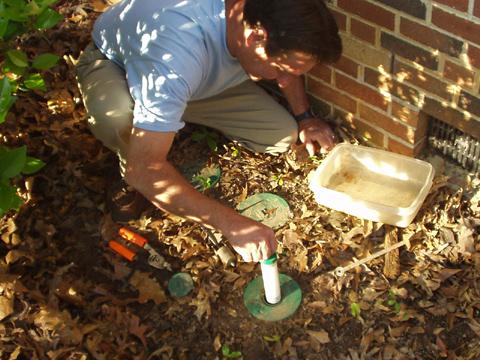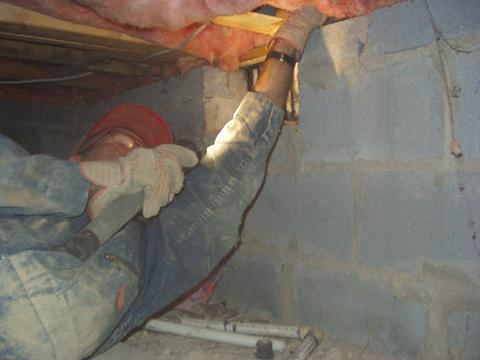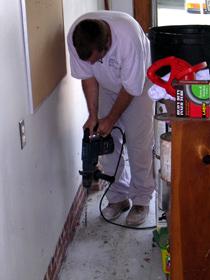Why Termite Baits?
| NOTE: This discussion applies to the use of termite baits in North Carolina. If you live outside North Carolina, you should contact your state/county Cooperative Extension office, your state's land-grant university or state regulatory agency for local information concerning the availability and use of these products. |
Baits are an important tool for termite prevention and control programs. The most common method of termite treatment on a home is done with a soil-applied liquid termiticide. However, there are a number of situations where a baiting system may be preferred or the only alternative to a liquid treatment or may even be used to supplement a liquid treatment. For example:
- A liquid treatment may be too difficult:
- There is a foundation drain around the house exterior or under a slab and chemical could leak into a pond, creek, or other body of water.
- Heating/air conditioning ducts are located under or in a slab floor that might require drilling so the underlying soil can be treated.
- A proper treatment would require extensive drilling of a slab that is covered by a wood, tile or carpeted flooring, or drilling through other masonry such as a finished basement wall.
- A standard soil treatment may be illegal under federal, state and/or municipal regulations, e.g., when there is a well or cistern under or too close to the house.
- You prefer an alternative to soil treatments for whatever reason.
Which Is the Best Method of Termite Control?
Because liquid treatments and bait treatments are applied (and also work) very differently from each other, it is difficult to compare the two methods in terms of which works "better". Soil-applied liquid termiticides act as chemical barriers to stop invading termites and to kill the termites that are actively infesting the structure. Termites encounter these treated barriers during the course of their normal underground foraging ("food hunting") activities. Some termiticides, such as those containing fipronil (Termidor®), imidacloprid (Premise®), or chlorantraniliprole (Altriset®), kill termites more slowly when the insects come in contact with the treated soil. Studies indicate that the "contaminated" termites may pass some of these non-repellent chemicals to other members of their colony which increases the overall impact of the termiticide.
Some termite baiting systems use strips of wood or cartridges containing compressed cellulose materials that act as monitors to detect termite activity before the bait is inserted. Other termite baits do not use monitors but simply use a compressed cellulose material that contains the chemical. All of the current termite baiting systems use bait stations that are inserted into the soil about 2-4 feet away from the foundation and at no more than 20-foot apart around your home. They may be placed closer when areas contain potentially infested items, such as a tree stump.
Some people refer to the bait stations as "traps". The stations do not trap the termites in them. Just as with the use of ant baits, termite baits are only effective if the worker termites find and consume the bait and carry it back to the colony where it is shared with other colony members. It is important to realize that the current termite bait and baiting systems do not "attract" termites. The termite workers find the stations (and their contents) during their atrual foraging activities, just as they might find any other underground food source, such as the roots of tree stumps or buried (and untreated) wood. If the "food" in the station is considered acceptable to the termites, more individuals will come to feed on it. There is no way to predict how soon termites will find and feed in a bait station. So, an important part of the baiting strategy is to install the stations completely around the structure and to target known or suspected sites of termite activity. For that reason, a thorough inspection of the house and immediate property is important before the stations are installed. Also, weather may adversely affect termite foraging. For example, very cold temperatures in the winter may reduce termite activity in the soil. If the soil becomes very dry during periods of drought, termites may move further down in the soil or stay in surrounding, more moist soils (such as in mulched or irrigated areas). As a result, they may be less likely to travel to bait stations in the drier areas.
Baiting Is a Long Term Approach to Termite Control
Unlike most conventional insecticides, the impact of termite baits is not immediate. By design, the insecticides used in the baiting systems are slow acting insect growth regulators (IGRs). This allows the bait to be spread by the foraging worker termites to other members of the colony that do not go out and collect their own food. This includes the reproductives (the king and queen) and the soldier termites, as well as those workers that maintain the nest and tend new offspring. Unlike insecticides that affect the insect's nervous system, the IGRs disrupt the ability of the insects to molt, which means that they only affect immature termites that are still growing. The IGRs do not affect the queen, king, soldiers and adult workers. However, most of the colony is made up of immature termites (larvae and nymphs) which can be affected. As a result, it may take several months before the entire colony is substantially reduced or even eliminated. As the workers die, there are fewer termites available to collect food and feed the rest of the colony. Eventually, the king and queen (and soldiers) starve to death and the colony dies off.
The time of year that the bait is installed will also affect how quickly termite activity is eliminated. For example, if the bait system is installed in the fall against an active infestation, feeding on the bait may slow as temperatures drop (althought the soil temperature may not decrease as quickly). So, you might still see activity, including swarming (winged) termites in the spring. This same situation may occur even with a liquid treatment that is done very late in the year (or in the winter).
The baiting program continues year-round as long as you maintain your contract with the pest control company. The key to a successful termite baiting program is proper monitoring and maintenance of the stations. Make sure you understand the monitoring/inspection schedule followed by the company and that you receive regular updates after every inspection, which may occur quarterly or annually.
Possible Drawbacks to Termite Baiting Systems
This issue does not have a simple answer, but here are a few points for you to consider:
Treatment Cost - the initial cost of the baiting system may be higher than that for a liquid treatment. Termite treatments, whether they're baits or liquids, are labor-intensive and based largely on the dimensions of the house. The size and complexity of how your home is built can affect both baiting and liquid treatments in similar ways. For example, larger houses will require more soil-applied chemical or more bait stations in order to do the job compared to a house with a smaller footprint. However, the cost for a liquid treatment can be affected more significantly by factors such as the type of construction. For example, drilling and treating concrete slabs, such as garages, porches and patios, and masonry voids (block foundation walls) is required under North Carolina rules (and often by the product labels). This increases both labor and chemical costs. Also, since liquid termiticides are applied to a vertical area of soil and must reach a certain depth (4' or the top of the footer, whichever is less), a basement house could cost as much as 4X more to treat compared to a crawlspace or slab house of the same size depending on how deep (below grade) the basement extends and if drilling is needed. As noted earlier, in many instances a house may not treatable with a liquid termiticide (e.g., wells under the house) OR a liquid treatment may be difficult or environmentally questionable. In these situations, the seemingly higher "cost" of a baiting system must be weighed against its benefits in protecting you and the environment.
Contract Maintenance - You can probably go anywhere on your property and find termites, but that doesn't mean that they are constantly attacking your house. It does mean that there is always a chance that termites may find a way to invade the house. Although we expect liquid termiticides to remain effective in the soil for at least five years (usually longer), this does not guarantee that termites will not invade your house for 5 years. An annual inspection is the only way to maintain that level of protection on your house. As with the termite treatment itself, the cost of the annual contract renewal can be affected by factors such as type of construction which can impact on the extent of any post-treatment routine inspection. For example, certain types of slab homes as well as homes with finished basements have far less exposed areas where you might be able to detect termites when they first invade the home. Pest control companies may charge more for an annual contract simply because of the greater risk (to them and to you) if they cannot detect termites in a timely manner. It is somewhat similar to having higher medical insurance premiums because of some previous health problems that make you a greater "risk" for certain medical problems in the future. The renewal for a baiting system contract is likely to cost 2x-4x more than one for a liquid treatment because the bait stations are typically checked at annually or as much as four times per year (more frequently when termites actually attack a station) whereas houses treated with a liquid soil treatment are inspected annually. The number of yearly bait station inspections is dictated by the product label. Also, with a termite baiting system, if you discontinue your contract, then the company usually removes the stations or simply stops servicing them. Depending on when the house was last treated (and with what chemical), quite likely you will be left with little, if any, chemical protection against termites and you may well need to have your house retreated conventionally at some point. The bottom line is that termite baiting requires a long-term commitment on your part. Take this point into consideration when making your decision.
NOTE: If you decide that you prefer the baiting system approach, make sure that your contract includes an annual inspection of your house. No chemical termite treatment, whether it's a liquid or a bait system, is going to be 100% effective every time. If there is termite activity in your crawlspace or basement and it's ignored for many years, you could end up with serious damage. An annual inspection of your house is critical - make sure that the pest control company provides one.
Current Termite Baiting Systems
The information presented here is not intended as an endorsement of one bait product over another or for the use of the baits over liquid termiticides. As with any termite control product, we recommend that you
- Read all available literature about the product and make sure that you understand how the product works and what guarantee(s) the pest control company will provide to protect your home from further termite attack and damage.
- If you're not clear on any detail about the product ask questions before you sign the contract.
All of the currently approved professional termite bait products are registered for "standalone" use, i.e., as the sole means of controlling the termites. There is a termite bait called, Terminate (Spectrum Brands), which is available to the public at many retail stores. However, this product label clearly states "Not recommended as sole protection against termites, & for active infestations, get a professional inspection". Some pest control companies may recommend that they first treat the soil with a liquid (if possible) to stop current termite activity in the house either to the immediate area of termite activity (i.e., a "spot" treatment) or possibly to the entire exterior of the structure with the baits serving as a monitoring/supplemental control component. Before signing a contract for any termite treatment, make sure that you understand what control methods will be used and to what extent each is serving in protecting your home and the additional cost of combined methods (versus the use of either a bait or liquid treatment alone). Below, you will find information about the common baiting/monitoring systems registered for use in North Carolina by pest control professionals. These products are listed alphabetically. The mention here of specific products is not an endorsement of any one product over another or suggesting that baiting is better or worse than a soil treatment. The information is here to provide you with basic understanding of termite baiting and to allow you to pursue additional information before making a decision on how to proceed in protecting your home:
- Exterra® Termite Interception and Baiting System (Ensystex) - Exterra uses inground monitoring-baiting system. When the stations are installed, they contain only cellulose "interceptors". When termites are found feeding on the interceptors in the station, the bait matrix is inserted into the station's central cavity. The bait, Labyrinth®, is a cellulose-based material that contains the insect growth regulator "diflubenzuron". Exterra can be used by itself, although localized ("spot") treatments with liquid termiticides are often used when the stations are installed. Exterra also has an aboveground baiting system that can be where infestations are accessible within the structure. For more information about the product: phone: 888-Exterra (398-3772)
- Sentricon Colony Elimination System® (Corteva AgroSciences). Sentricon is a monitoring-baiting system. Inground stations are installed around a structure at specific intervals (not exceeding 20 feet). The original Sentricon system used wooden monitors. When termites were found in the monitoring station, the monitors are replaced with a bait tube containing Recruit® IV with the insect growth regulator "noviflumuron." With the newer version of Sentricon, referred to as "Always Active," the stations are installed with the bait (Recruit® HD) already inside them. An aboveground station, Recruit®IV AG, is used in conjunction with the inground stations when termites are directly accessible within the structure. Sentricon is labeled for use by itself, although some companies may use a "spot" liquid treatment at sites of known termite activity. For information about this product: phone: 800-686-6200
- Trelona® Advance Termite Bait System ("ATBS") (BASF). Trelona ATBS is a monitoring-baiting system that uses the insect growth regulator "novaluron." At the time of installation, the stations are pre-baited with two levels: one a grooved cylinder of wood and the other a Puri-Cell™ monitoring matrix. When termites are found feeding in a station, a termite bait cartridge is inserted on top of the wood monitoring base. Trelone ATBS can be used as a standalone product although many companies employ a liquid spot treatments of soil in the vicinity of known termite activity.
Conclusion
If a professional inspection of your home confirms the presence of termites, some sort of corrective measure is strongly recommended. Your efforts and monetary expenditures are probably best spent on getting the best possible professional service that you can find. Termite control, whether it is through the use of soil-applied liquids, bait products, or other recognized mechanical methods is best performed by a trained and licensed professionals.
For more information see:
Publication date: June 19, 2017
Reviewed/Revised: April 13, 2020
NC Cooperative Extension prohíbe la discriminación por raza, color, nacionalidad, edad, sexo (incluyendo el embarazo), discapacidad, religión, orientación sexual, identidad de género, información genética, afiliación política, y estatus de veteran.
Recommendations for the use of agricultural chemicals are included in this publication as a convenience to the reader. The use of brand names and any mention or listing of commercial products or services in this publication does not imply endorsement by NC State University or N.C. A&T State University nor discrimination against similar products or services not mentioned. Individuals who use agricultural chemicals are responsible for ensuring that the intended use complies with current regulations and conforms to the product label. Be sure to obtain current information about usage regulations and examine a current product label before applying any chemical. For assistance, contact your local N.C. Cooperative Extension county center.
N.C. Cooperative Extension prohibits discrimination and harassment regardless of age, color, disability, family and marital status, gender identity, national origin, political beliefs, race, religion, sex (including pregnancy), sexual orientation and veteran status.




